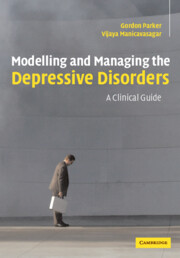Book contents
- Frontmatter
- Contents
- Acknowledgements
- Introduction
- Part I The current model for depressive disorders and its impact on clinical management
- Part II The diagnosis and management of melancholic and psychotic depression
- Part III An introduction to non-melancholic depression
- Part IV Modelling and managing the non-melancholic depressive disorders
- 13 Acute stress-related non-melancholic depression
- 14 Acute stress-related non-melancholic depression: ‘key and lock’ model
- 15 Chronic stress-related non-melancholic depression
- 16 The perfectionist personality style and non-melancholic depression
- 17 Irritability and non-melancholic depression
- 18 Anxious worrying and non-melancholic depression
- 19 Social avoidance and non-melancholic depression
- 20 Personal reserve and non-melancholic depression
- 21 Rejection sensitivity and non-melancholic depression
- 22 Self-focused personality style and non-melancholic depression
- 23 Self-criticism and non-melancholic depression
- 24 Natural and alternative treatments for non-melancholic depression
- Appendix 1 The DMI-18 and the DMI-10
- Appendix 2 The CORE system of measuring psychomotor disturbance
- Appendix 3 The temperament and personality measure
- References
- Index
19 - Social avoidance and non-melancholic depression
from Part IV - Modelling and managing the non-melancholic depressive disorders
Published online by Cambridge University Press: 17 August 2009
- Frontmatter
- Contents
- Acknowledgements
- Introduction
- Part I The current model for depressive disorders and its impact on clinical management
- Part II The diagnosis and management of melancholic and psychotic depression
- Part III An introduction to non-melancholic depression
- Part IV Modelling and managing the non-melancholic depressive disorders
- 13 Acute stress-related non-melancholic depression
- 14 Acute stress-related non-melancholic depression: ‘key and lock’ model
- 15 Chronic stress-related non-melancholic depression
- 16 The perfectionist personality style and non-melancholic depression
- 17 Irritability and non-melancholic depression
- 18 Anxious worrying and non-melancholic depression
- 19 Social avoidance and non-melancholic depression
- 20 Personal reserve and non-melancholic depression
- 21 Rejection sensitivity and non-melancholic depression
- 22 Self-focused personality style and non-melancholic depression
- 23 Self-criticism and non-melancholic depression
- 24 Natural and alternative treatments for non-melancholic depression
- Appendix 1 The DMI-18 and the DMI-10
- Appendix 2 The CORE system of measuring psychomotor disturbance
- Appendix 3 The temperament and personality measure
- References
- Index
Summary
Social avoidance personality style
People with features of this personality style tend to shy away from social stimulation and are usually reluctant to socialise or mix with others at parties or other social gatherings. They may appear shy or distant around people, especially those they have not previously met. Features of this personality style include a preference for solitude and solitary activities. There is the danger that, when stressed or upset, people with features of this type of personality style completely withdraw from social activity and thus hinder the likelihood of deriving support from others, including seeking professional help.
Key features of the Social Avoidant Personality Style (derived from our Temperament and Personality Questionnaire):
Dislikes social stimulation or mixing with others.
Avoids parties and other social gatherings.
Reserved in social situations.
Quiet around others.
Holds back on meeting new people.
Prefers own company to that of others.
High levels of anxiety and self-criticism in social situations may characterise this personality style. There may also be a history of early adverse experiences surrounding social situations, such as being bulled or humiliated at school or teased by siblings at home. People with features of this personality style may have organised their lives to exclude or minimise interaction with others. For example, by choosing occupations that require solitary rather than team activities, and maintaining a small group of friends and acquaintances who are unlikely to threaten or make demands on their time.
- Type
- Chapter
- Information
- Modelling and Managing the Depressive DisordersA Clinical Guide, pp. 164 - 173Publisher: Cambridge University PressPrint publication year: 2005



